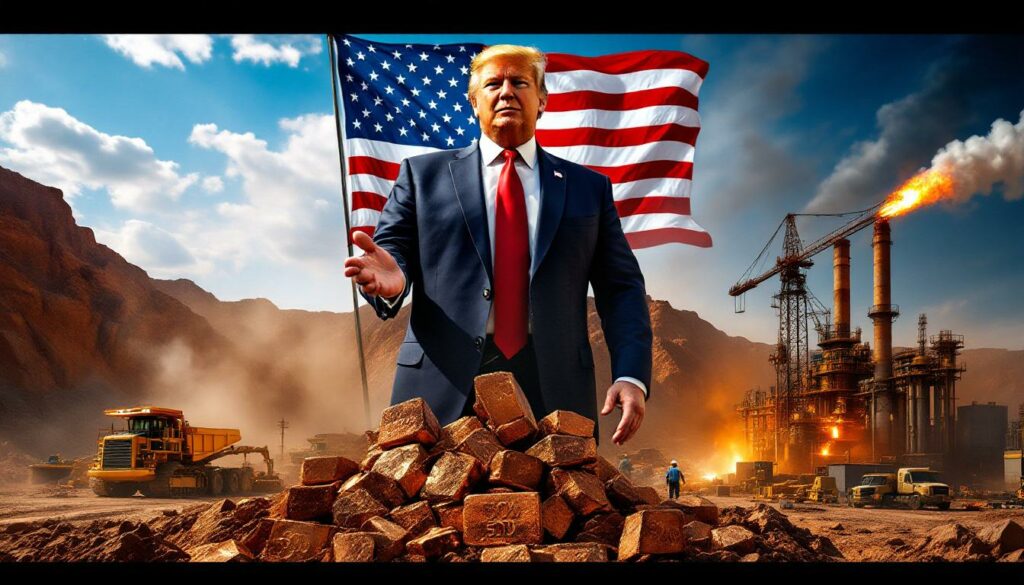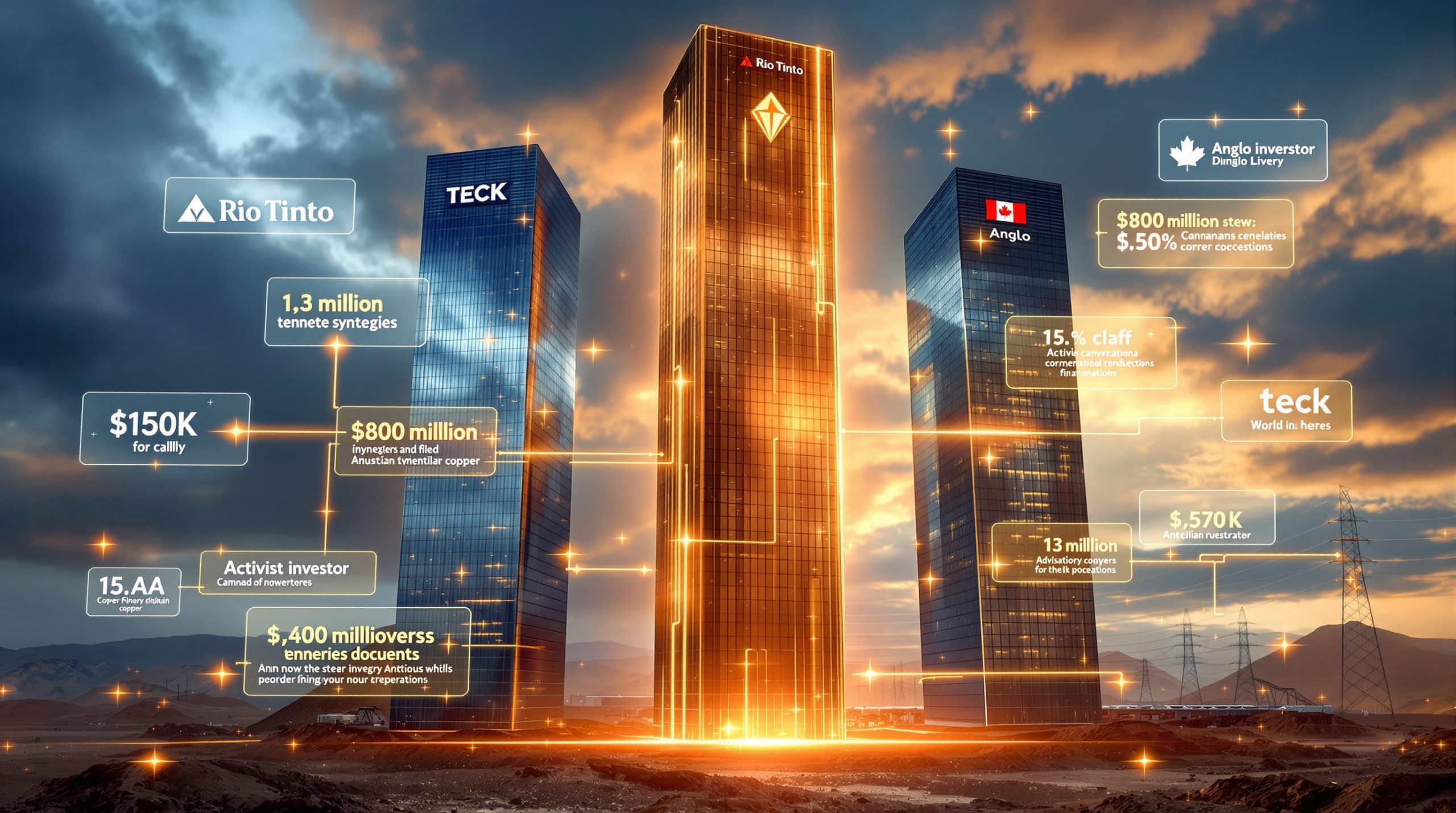How Will Trump's Copper Tariffs Impact US Mining Investment?
The recent announcement of a 50% tariff on copper imports by the Trump administration has sent ripples through global markets and created new opportunities for domestic mining operations. This significant policy shift aims to reduce American reliance on foreign copper supplies while stimulating investment in local production capacity.
The tariffs target one of America's most critical industrial metals, used extensively in electrical wiring, electronics, construction, and increasingly in renewable energy infrastructure and electric vehicles. With copper price predictions suggesting rates over $5.60 per pound following the announcement, mining companies with US assets are strategically reassessing their investment plans.
Rio Tinto, one of the world's largest mining companies, has quickly signaled its interest in expanding American copper operations. As CEO Katie Jackson stated: "There is increasing recognition by the US government of the need for domestic sources of copper to support manufacturing and to power the country's energy future. We have a strong desire to invest more in American copper."
Understanding the New Copper Tariff Landscape
The 50% tariff represents one of the most aggressive trade policy measures aimed at reshaping America's industrial supply chain. For decades, the US has relied heavily on copper imports from Chile, Peru, and other major producing nations, creating vulnerability in critical manufacturing sectors.
This dependency becomes particularly concerning when examining copper's role in:
- Renewable energy infrastructure (solar panels, wind turbines)
- Electric vehicle production (motors, batteries, charging systems)
- Defense applications (communications systems, weapons platforms)
- Construction (plumbing, electrical wiring, roofing)
- Consumer electronics (circuit boards, wiring, connectors)
The tariff policy aims to address a significant supply-demand imbalance. Despite being the world's largest economy, the US currently produces only about 8% of global copper supply while consuming approximately 18% of world production. This gap represents both a national security concern and an economic opportunity for mining companies.
However, industry analysts caution that tariffs alone cannot instantly solve America's copper deficit. Developing new mines requires years of permitting, billions in investment, and overcoming significant regulatory hurdles. The policy nonetheless creates a more favorable economic environment for companies considering long-term copper investment strategies.
Rio Tinto's Investment Position in American Copper
Rio Tinto stands uniquely positioned to capitalize on the changing copper landscape in America. The company already maintains significant copper operations in the country and has signaled intentions to expand its footprint substantially.
"We see significant opportunities to grow our business in the United States," noted CEO Katie Jackson in response to the tariff announcement. This statement aligns with Rio Tinto's broader strategy of diversifying its global portfolio while securing positions in politically stable mining jurisdictions.
The company's American copper strategy centers around two major assets: the Resolution Copper project in Arizona and the Kennecott operations in Utah. Both represent critical components in any plan to boost domestic copper production.
Resolution Copper Project: A Potential Game-Changer
The Resolution Copper project, a joint venture between Rio Tinto (55%) and BHP Group (45%), represents what could become North America's largest copper mine. Located near Superior, Arizona, the project contains one of the world's largest undeveloped copper deposits, with mineralization extending more than 7,000 feet below the surface.
Recent developments have significantly improved the project's prospects. In April 2025, the Supreme Court rejected an appeal by Apache Stronghold, an Indigenous group that had challenged the federal government's authority to transfer land for the mine. This decision removed a critical legal obstacle that had stalled the project for years.
Resolution Copper's potential impact on American copper supply cannot be overstated. Industry experts estimate the mine could eventually produce up to 25% of U.S. copper demand, with an operational lifespan exceeding 40 years. The deposit contains an estimated 1.6 billion metric tons of ore at an average grade of 1.47% copper.
The economic benefits extend beyond simple production numbers:
- Job creation: Approximately 3,700 direct and indirect jobs during peak construction
- Long-term employment: 1,400+ permanent positions when fully operational
- Economic impact: Estimated $61 billion contribution to Arizona's economy over the mine's life
- Tax revenue: Projected $20 billion in federal, state, and local taxes
Despite these promising figures, significant challenges remain. The project still requires completion of a comprehensive Environmental Impact Statement and must navigate additional regulatory requirements before construction can begin.
Kennecott Operations: America's Copper Processing Hub
While Resolution Copper represents Rio Tinto's future in American copper, the company's Kennecott operations in Utah serve as its current production base. Kennecott stands as one of only two functioning copper smelters in the United States, making it a strategic asset in a tariff-protected environment.
The Kennecott complex includes:
- An open-pit copper mine (Bingham Canyon)
- Concentrating facilities
- A smelter
- A refinery producing copper cathode
This integrated operation allows Rio Tinto to process copper ore all the way to finished metal without relying on overseas processing facilities. With many copper mines in the US lacking access to domestic processing capacity, Kennecott's smelter becomes even more valuable under the new tariff regime.
The operation currently produces approximately 300,000 tons of refined copper annually, along with gold, silver, and molybdenum byproducts. With tariff protection potentially improving economics, Rio Tinto could justify further investment in expanding Kennecott's processing capacity to handle additional domestic copper concentrate.
"Kennecott's integrated operations provide a complete production pipeline from ore to refined metal, representing a model for what America's copper industry could become with proper investment," notes industry analyst Sarah Thompson of Metal Market Intelligence.
What Challenges Remain for US Copper Development?
Despite the economic incentives created by tariffs, significant barriers continue to impede rapid expansion of US copper production. These challenges span regulatory, technical, and economic domains, potentially limiting how quickly America can reduce its import dependence.
Permitting and Regulatory Hurdles
The permitting process for new mines in the United States ranks among the most complex and time-consuming globally. While the tariff policy creates economic incentives for copper development, it doesn't automatically accelerate the regulatory approval process.
Key permitting challenges include:
- Extended timelines: New mine permits typically take 7-10 years in the US, compared to 2-3 years in countries like Australia and Canada
- Multiple agencies: Projects must navigate approvals from federal, state, and local authorities
- Environmental reviews: Comprehensive Environmental Impact Statements require extensive studies and public comment periods
- Legal challenges: Even approved projects often face years of litigation from environmental or community groups
As MINING.com analysis notes: "Permitting obstacles and litigation still stand in the way of building mines quickly." This reality creates a significant lag between policy change and production response, potentially limiting the short-term effectiveness of tariffs in boosting domestic supply.
The Resolution Copper case illustrates this challenge perfectly. Despite its enormous potential and recent legal victory, the project still faces a lengthy permitting process before construction can begin.
Infrastructure and Technical Requirements
Beyond regulatory challenges, developing new copper production requires massive infrastructure investment and specialized technical expertise. These requirements cannot be rapidly improvised, even with favorable economics.
Critical infrastructure needs include:
- Power supply: Modern copper mines require substantial electricity for operations
- Water management: Processing facilities need reliable water sources in often arid regions
- Transportation networks: Rail, road, and port access for moving equipment and products
- Processing capacity: Limited domestic smelting capacity creates bottlenecks
The skilled workforce required for modern mining operations presents another challenge. Decades of declining mining activity have reduced America's pool of experienced miners, engineers, and metallurgists. Training programs and educational initiatives will be necessary to rebuild this workforce.
Additionally, copper mining faces increasing technical complexity. Many remaining US copper deposits are lower-grade or more difficult to access than historical mines. This reality requires more sophisticated mining methods, advanced processing technologies, and larger capital investments to develop economically viable operations.
How Does This Align With US Critical Minerals Strategy?
The copper tariffs represent part of a broader strategic shift in how the United States approaches mineral security. After decades of increasing import dependence, policymakers have begun recognizing the vulnerability created by relying on foreign sources for critical materials.
Government Recognition of Copper as a Critical Material
While not officially designated as a "critical mineral" on government lists that focus on rare earth elements and battery metals, copper has increasingly been acknowledged as strategically important. Its essential role in electrical infrastructure, renewable energy systems, and defense applications makes secure supply chains a national priority.
As Rio Tinto CEO Katie Jackson observed: "There is increasing recognition by the US government of the need for domestic sources of copper to support manufacturing and power the energy future."
This recognition manifests in several policy approaches:
- Trade measures: Tariffs to protect domestic producers
- Permitting reform initiatives: Efforts to streamline mine approvals
- Defense stockpiling: Strategic reserves of essential materials
- Research funding: Development of alternative materials and recycling technologies
The copper tariff policy connects directly to broader economic and security objectives, including:
- Manufacturing resurgence: Supporting domestic production of value-added goods
- Energy transition: Ensuring material availability for renewable infrastructure
- National security: Reducing dependence on potentially unreliable foreign suppliers
- Job creation: Revitalizing mining communities in resource-rich states
"Copper represents the backbone of our electrical infrastructure and energy transition. Domestic supply security isn't just an economic issue—it's a national security imperative," explains Dr. James Reynolds, former Department of Energy metals analyst.
Supply Chain Security Considerations
The current US copper supply chain reveals significant vulnerabilities. The country imports approximately 35% of its refined copper consumption, with that percentage rising for certain high-grade products. When including copper contained in manufactured goods, import dependence grows even larger.
This dependence creates several security risks:
- Supply disruptions: Political instability or labor disputes in producing countries
- Price volatility: Exposure to international market fluctuations
- Quality control: Varying standards in foreign production
- Geopolitical leverage: Foreign suppliers potentially using materials access as political leverage
Transitioning toward greater self-sufficiency requires a multi-decade strategy. Even with favorable economics created by tariffs, developing new mines and expanding processing capacity will take years. Industry experts suggest a realistic timeline of 5-15 years before significant production increases materialize from new projects.
In the interim, tariffs may incentivize greater extraction from existing mines, expansion of current operations, and investment in projects already in advanced development stages. These incremental improvements could begin affecting supply chains within 2-3 years.
What Are the Market Implications of US Copper Investment?
The combination of tariffs and increased domestic investment will reshape copper markets both within the US and globally. These changes create winners and losers across industries and international boundaries.
Price Effects and Economic Impact
The immediate market response to the tariff announcement saw copper prices jump significantly, trading at $5.605 per pound. This price increase affects different economic sectors in varying ways:
Industries facing higher costs:
- Construction: Higher prices for plumbing and electrical components
- Electronics manufacturing: Increased costs for circuit boards and components
- Automotive production: Higher expenses for wiring harnesses and electrical systems
- Renewable energy development: More expensive solar and wind infrastructure
Beneficiaries of the policy:
- Domestic mining companies: Improved profit margins and project economics
- Mining equipment manufacturers: Increased demand for specialized machinery
- Engineering and construction firms: Opportunities from mine development
- Mining communities: Job creation and economic revitalization
The regional economic benefits could be substantial in copper-rich states like Arizona, Utah, Nevada, and Michigan. Analysis from the American Mining Association suggests each new large-scale copper mine could generate:
- 300-500 direct mining jobs
- 1,000-1,500 indirect support positions
- $25-50 million in annual tax revenue for local communities
- Significant multiplier effects in local service and retail businesses
However, the policy creates potential challenges for manufacturing sectors that rely heavily on copper inputs. Without careful implementation, tariffs could disadvantage American manufacturers competing in global markets if they face higher material costs than international competitors.
Global Market Reactions
International response to the US tariff announcement has been swift. Chile, the world's largest copper producer and a major US supplier, immediately demanded "official communication" regarding the policy, reflecting concern about impacts on its export-dependent economy.
Other potential reactions from copper-producing nations might include:
- Trade retaliation: Targeting American exports with countervailing duties
- WTO challenges: Filing formal complaints over potential trade agreement violations
- Strategic realignment: Seeking alternative markets like China and the EU
- Investment redirection: Focusing on value-added processing rather than raw exports
The global copper market is likely to segment partially in response to tariffs, with price differentials developing between protected and open markets. This fragmentation could create arbitrage opportunities and complex supply chain adjustments as traders and manufacturers seek to optimize under the new rules.
Mining companies with global portfolios face strategic decisions about where to allocate capital. While US projects become more attractive under tariff protection, international miners must balance these opportunities against potential negative impacts on their operations in countries like Chile, Peru, and Indonesia.
What Is Rio Tinto's Strategic Vision for US Operations?
Rio Tinto's approach to the changing US copper landscape reflects a comprehensive strategy that balances short-term opportunities with long-term positioning. The company appears poised to significantly expand its American footprint.
Long-Term Investment Potential
Rio Tinto's statement that it sees "significant opportunities to grow our business in the United States" suggests a multi-faceted investment approach. Industry analysts anticipate the company may pursue several parallel strategies:
- Accelerating Resolution Copper development: Capitalizing on the recent legal victory to advance permitting and pre-construction activities
- Expanding Kennecott operations: Potentially increasing processing capacity and extending mine life
- Exploring acquisition opportunities: Targeting junior miners with advanced copper projects
- Forming strategic partnerships: Collaborating with other miners to develop new projects
When compared to Rio Tinto's global copper portfolio, which includes major operations like Oyu Tolgoi (Mongolia), Escondida (Chile), and Northparkes (Australia), the US assets currently represent a relatively small portion of total production. However, the combination of tariff protection and Resolution Copper's massive potential could significantly rebalance this portfolio over the next decade.
The company's integrated approach—controlling both mining and processing assets—provides competitive advantages over miners that lack smelting capacity. This vertical integration becomes particularly valuable in a tariff-protected environment where access to domestic processing represents a crucial advantage.
Sustainability and ESG Considerations
While the economic case for US copper investment strengthens under tariffs, Rio Tinto must also navigate increasing environmental, social, and governance (ESG) expectations. The company has committed to implementing stringent sustainability practices in its American operations.
Key sustainability challenges for US copper development include:
- Water management: Developing operations in water-stressed regions of the Southwest
- Indigenous relations: Addressing concerns from Native American communities
- Carbon footprint: Reducing emissions from energy-intensive mining and processing
- Land reclamation: Planning for effective post-mining restoration
Rio Tinto has pledged to make Resolution Copper a model of modern sustainable mining, incorporating:
- Advanced water recycling systems targeting 90%+ reuse rates
- Renewable energy integration to reduce carbon emissions
- Underground mining techniques that minimize surface disturbance
- Community benefit agreements ensuring local economic participation
"The next generation of American copper mines must set global standards for environmental performance and community engagement. The social license to operate is as important as any permit," emphasizes environmental mining consultant Dr. Elaine Richards.
The company's approach to Indigenous relations remains particularly scrutinized following the controversial Apache Stronghold legal battle. Rio Tinto has committed to ongoing consultation and benefit-sharing arrangements, though skepticism remains among some tribal representatives.
FAQ: US Copper Mining Expansion
When could Resolution Copper begin production?
While Rio Tinto has not released an updated timeline following the recent Supreme Court decision, industry analysts suggest the following potential schedule:
- 2025-2027: Completion of Environmental Impact Statement and permitting
- 2027-2030: Construction phase (approximately 3 years)
- 2030-2031: Initial production and ramp-up
- 2031 onward: Full-scale operations
This timeline remains subject to regulatory progress and potential legal challenges. The project's underground nature and technical complexity require extensive development work before ore production can begin.
How will domestic copper prices compare to international markets?
With a 50% tariff, US copper prices will likely maintain a significant premium over international markets, though not necessarily the full tariff amount. Several factors will influence the price differential:
- Import substitution capacity: Limited domestic production capacity means some imports remain necessary despite tariffs
- Manufacturing demand: Price sensitivity of downstream industries
- Tariff implementation details: Potential exemptions or phase-in periods
- Smuggling and transshipment: Enforcement challenges that could undermine tariff effectiveness
Over time, increased domestic production should moderate price premiums, though experts expect American copper to remain more expensive than global benchmarks as long as tariffs remain in place.
What other mining companies might increase US copper investments?
Several mining companies beyond Rio Tinto possess significant US copper assets or development projects that could benefit from tariff protection:
- Freeport-McMoRan: America's largest copper producer, operating several mines in Arizona and New Mexico
- BHP Group: Rio Tinto's partner in Resolution Copper an
Ready to Stay Ahead of the Next Copper Discovery?
Don't miss out on real-time alerts for significant ASX copper discoveries and investment opportunities, powered by Discovery Alert's proprietary Discovery IQ model. Visit our discoveries page to see how major mineral discoveries can lead to substantial returns and begin your 30-day free trial today.




